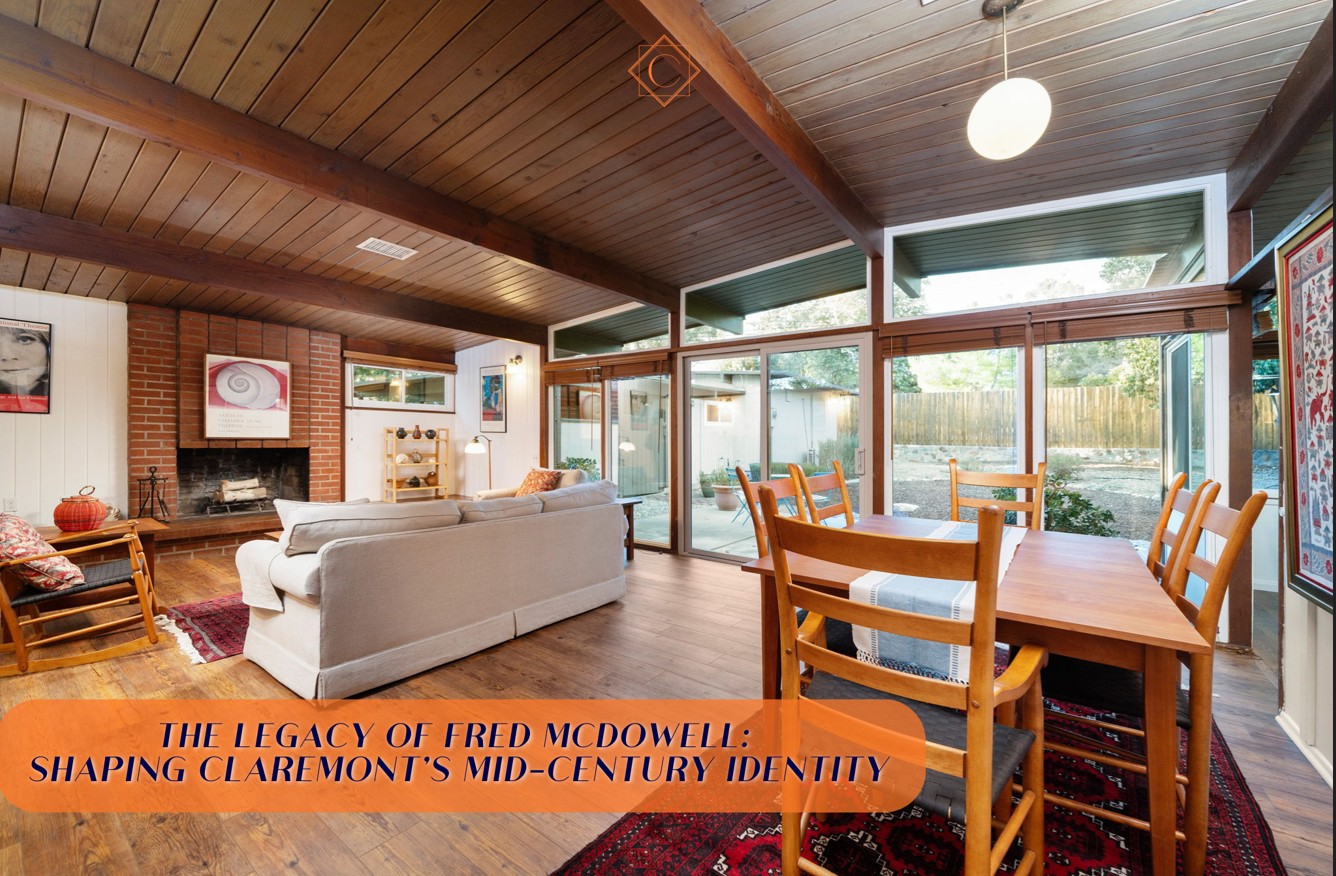Claremont, California is known for its tree-lined streets, artistic community, and remarkable architectural history. Among the visionaries who helped define that character, Fred W. McDowell remains one of the most influential names in Claremont architecture. His designs are considered the foundation of what many now call “Claremont Modern” — a movement that continues to shape the city’s most admired neighborhoods and attract homebuyers who appreciate timeless design.
McDowell’s architectural work bridges art, landscape, and modernist ideals, creating spaces that still feel relevant and elegant in today’s Claremont real estate market.
Early Life and Arrival in Claremont
Fred McDowell was born in 1923 in Riverside, California. After serving in the Navy during World War II, he studied at the USC School of Architecture, graduating in 1946. Early in his career, McDowell taught at USC, completed graduate work in planning, and briefly worked in the Los Angeles office of Richard Neutra, a pioneer of mid-century modernism.
McDowell later moved to Claremont, where he formed a partnership in 1957 with respected architect Theodore Criley. Their firm, Criley & McDowell, became one of the most recognized architectural practices in the city. Even after Criley’s passing in 1984, McDowell continued designing in Claremont and the surrounding foothill communities. His obituary fittingly described him as “synonymous with local architecture.”
Today, his work stands as a testament to the values that make Claremont homes so unique — quality craftsmanship, harmony with the environment, and a focus on livable design.
Signature Projects and Design Philosophy
McDowell’s body of work includes many of Claremont’s most celebrated mid-century homes and landmarks. His designs emphasize openness, simplicity, and connection to nature — qualities that continue to inspire architects and homeowners across the city.
The Eldridge House
Located on Blaisdell Drive, the Eldridge House (1963) is a cornerstone of Claremont Modern design. This home features exposed wood framing, walls of glass, and a thoughtful floor plan that wraps around a landscaped courtyard. McDowell described his design philosophy as a “total environment,” meaning every detail — from terrain and materials to landscaping — was planned to work together as one.
The McIntosh House
Built in 1958 for ceramicist Harrison McIntosh and his wife Marguerite, the McIntosh House remains a highlight of Claremont’s architectural tours. The home’s open post-and-beam structure, natural wood finishes, and seamless integration with its surroundings perfectly express mid-century modern principles. It’s a favorite among Claremont home buyers who value art, design, and authenticity.
The Horizon Home Award
In 1964, McDowell’s design for 2535 North Mountain Avenue in Claremont earned the Western States Horizon Home Award for excellence in concrete and masonry design. This achievement helped place Claremont architecture on the map and showcased the city’s commitment to forward-thinking residential design.
Other Notable Works
McDowell is also credited as the architect of record for the Ken McLeod residence in Claremont, another fine example of mid-century architecture that remains influential in local design circles. In addition to residential work, Criley & McDowell contributed to several institutional projects at the Claremont Colleges, including master planning and library design that reflect the same modernist principles seen in their residential projects.
McDowell’s Enduring Impact on Claremont Real Estate
Fred McDowell’s architectural influence is woven into the fabric of Claremont’s real estate market. His homes are highly sought after for their craftsmanship, location, and enduring design appeal. Buyers searching for mid-century modern homes in Claremont often find that McDowell’s work captures the essence of what makes this community so desirable.
Defining Features of McDowell Homes
- Integration with nature: McDowell’s homes often open toward gardens, patios, and views of the San Gabriel Mountains.
- Natural materials and open structure: Exposed wood beams, stone, and glass define his approach to organic design.
- Artist collaborations: McDowell designed residences for several local artists, including Harrison McIntosh and Karl Benjamin. The Benjamin Residence (1955) overlooks a former orange grove and uses expansive glass walls to connect interior and exterior spaces.
- Preservation and recognition: Many of McDowell’s homes are featured in the Claremont Heritage Home Tour and museum exhibits such as “Claremont Modern: Post-War California Dreaming.” These ongoing efforts highlight the lasting importance of his work to Claremont’s identity.
His architectural vocabulary — clean lines, honest materials, and an emphasis on light and openness — continues to influence Claremont home design today. Whether through preservation or thoughtful renovation, his impact can be seen across neighborhoods from North Claremont to Padua Hills.
Tips for Homeowners and Buyers Interested in Mid-Century Homes
If you are exploring homes for sale in Claremont or interested in owning a mid-century modern residence, Fred McDowell’s work offers valuable insight into how design and lifestyle come together.
- Research the property’s history. Homes linked to McDowell or Criley often carry historical and cultural value within the Claremont housing market.
- Preserve the architectural integrity. When renovating, maintain the balance between structure, landscape, and materials that defines McDowell’s “total environment” concept.
- Modernize with care. Many mid-century homes benefit from energy-efficient updates while retaining their original charm.
- Use local resources. The Claremont Heritage organization and the Claremont Museum of Art are excellent sources for homeowners who want to learn more about the city’s architectural legacy.
Celebrating Claremont’s Architectural Heritage
At Concierge Realty Group, we take pride in representing homes that tell the story of Claremont’s rich architectural and cultural history. Fred McDowell’s legacy is more than a design style — it represents the creative spirit that makes Claremont real estate stand apart.
Whether you’re buying, selling, or simply exploring the beauty of Claremont homes, our team is here to share expert guidance rooted in deep local knowledge. From mid-century modern architecture to contemporary Claremont properties, we help our clients find homes that reflect the timeless elegance of this remarkable community.
Fred McDowell’s work continues to inspire Claremont — and so do the homes he helped shape.

